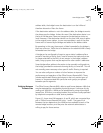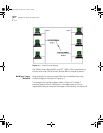
A
B
RIDGING
AND
R
OUTING
Introduction
During the initial configuration of the OfficeConnect Remote 840, you
must decide whether to configure the unit as a bridge or as a router. If
you are unsure which option you should choose, this section will help you
decide.
Bridges and routers are used to connect networks together. The cost of
connecting networks together is generally proportional to the distance
over which the network extends and the amount of bandwidth required.
Large amounts of bandwidth can be provided easily within a LAN by
connecting different segments together with a local bridge. However, it
becomes impractical and expensive to extend this bandwidth over larger
distances, and it is, therefore, usual to interconnect local high-speed
networks using bridges or routers connecting over slower speed
terrestrial and satellite links.
In the following sections we describe the concepts behind bridging and
routing, and discuss the different ways in which LANs can be configured
and operated to optimize performance and minimize disruption of traffic
on each individual LAN.
Bridging and
Routing Concepts
A bridge connects one or more LANs together. It examines each data
frame received at a LAN port and forwards any frames that it assumes are
for a destination device not connected to that LAN port. The bridge is
able to do this by learning which devices are connected to each LAN port.
A router learns much more about the networks connected to it and is
able to be much more selective about the data it passes on to other
networks and to which network it transmits. By default routers reject or
filter data unless it matches predefined attributes (for example, specific
protocols or destination network addresses). In large interconnected
networks, a router selects the best route for data to travel.
840ug.book Page 1 Friday, July 7, 2000 2:23 PM


















